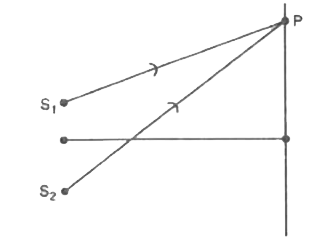In Young's double slit experiment, an interference pattern is obtained on a screen by a light of wavelength 6000 ∘A coming from the coherent sources S1andS2. At certain point P on the screen third dark fringe is formed. Then, the path difference S1P–S2P in micron isSolution in Telugu
0.75
1.5
3.0
4.5
The correct Answer is:B
Step by step video, text & image solution for In Young's double slit experiment, an interference pattern is obtained on a screen by a light of wavelength 6000 overset(circ)(A) coming from the coherent sources S_(1) and S_(2). At certain point P on the screen third dark fringe is formed. Then, the path difference S_(1) P – S_(2) P in micron is by Physics experts to help you in doubts & scoring excellent marks in Class 12 exams.
Updated on:21/07/2023Topper's Solved these Questions
- WAVES OPTICSBOOK - AAKASH SERIESCHAPTER - WAVES OPTICSEXERCISE - EXERCISE -III (DIFFRACTION)
11 Videos
- WAVES OPTICSBOOK - AAKASH SERIESCHAPTER - WAVES OPTICSEXERCISE - EXERCISE -III (POLARISITION)
10 Videos
- WAVES OPTICSBOOK - AAKASH SERIESCHAPTER - WAVES OPTICSEXERCISE - EXERCISE -II (POLARISATION)
11 Videos
- WAVESBOOK - AAKASH SERIESCHAPTER - WAVESEXERCISE - EXERCISE-III (Doppler effect :)
15 Videos
Similar Questions
Light of wavelength 6000A0 is incident on a single slit. The first minimum of the diffraction pattern is obtained at 4 mm from the centre. The screen is at a distance of 2m from the slit. The slit width will be
View SolutionA ray of light is incident on the surface of a glass plate of refractive index √3 at the polarising angle . The angle of refraction of the ray is
View SolutionThe angle of incidence at which reflected light is totally polarized for a ray travelling from air to glass (refractive index n), is
View SolutionWhen a train is approaching the stationary observer, the apparent frequency of the whistle observed as 100 Hz, while when it has passed away from the observer with same speed, it is 50 Hz. Calculate the frequency of the whistle when the observer moves with the train (V = 330 m/s)
View SolutionLet S1 and S2 be the two slits in Young's double-slit experiment. If central maxima is observed at P and angle ∠S1PS2=θ, then fringe width for the light of wavelength λ will be
View SolutionIn Young's double slit experiment, an interference pattern is obtained on a screen by a light of wavelength 6000Å, coming from the coherent sources S1 and S2. At certain point P on the screen third dark fringe is formed. Then the path difference S1P−S2P in microns is
View SolutionAt two point P and Q on screen in Young's double slit experiment, waves from slits S1 and S2 have a path difference of 0 and λ4 respectively. The ratio of intensities at P and Q will be:
View SolutionThree coherent sources S_(1), S_(2)" and" S_(3) can throw light on a screen. With S_(1) switched on intensity at a point P on the screen was observed to be I. With only S_(2) on, intensity at P was 2I and when all three are switched on the intensity at P becomes zero. Intensity at P is I when S_(1)" and" S_(2) are kept on. Find the phase difference between the waves reaching at P from sources S_(1) "and" S_(3) .
View SolutionIn the case of light waves from two coherent sources S_(1) and S_(2) , there will be constructive interference at an arbitrary point P, the path difference S_(1)P - S_(2)P is
View SolutionIn Young's double slit experiment, an interference pattern is obtained on a screen by a light of wavelength 6000 overset(circ)(A) coming from the coherent sources S_(1) and S_(2) . At certain point P on the screen third dark fringe is formed. Then, the path difference S_(1) P – S_(2) P in micron is
View SolutionIn an interference pattern the path difference between waves starting from S1 and S2 and reaching at P is 1.5 microns i.e. S2P−S1P=1.5 microns. If the wavelength of light used be 6000Å, then the point P is :

View SolutionAt two points P and Q on a screen in Young's double slit experiment, waves from slits S_(1) and S_(2) have a path difference of 0 and (lambda)/(4) respectively. The ratio of intensities at P and Q will be
View SolutionTwo coherent point sources S1 and S2 are separated by a small distance 'd' as shown. The fringes obtained on the screen will be :
View SolutionIn a modified set up of Young's double slit experiment, it is given that SS2−SS1=λ4 i.e., the source S is not equidistant from the slits S1andS2.
(a) Obtain the condition for constructive and destructive interference at any point P on the screen in terms of the path difference Δ=S2P−S1P.
(b) Does the observed central bright fringe lie above or below O ? Give reason in support of your answer.
View SolutionAt two points P and Q on a screen in Young's double slit experiment, waves from slits S1andS2 have a path difference of O and λ4 respectively. The ratio of intensities at P and Q will be ......
View SolutionIn the case of light waves from two coherent sources S1 and S2, there will be constructive interference at an arbitrary point P, the path difference S1P−S2P is
View Solution
